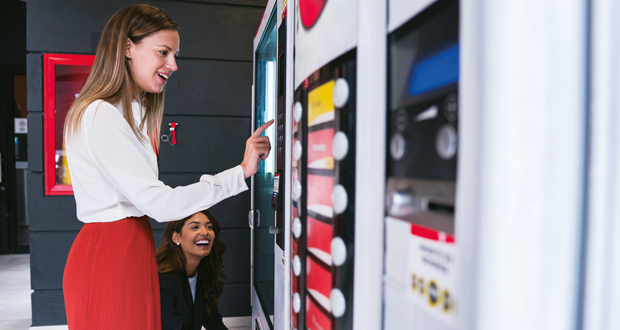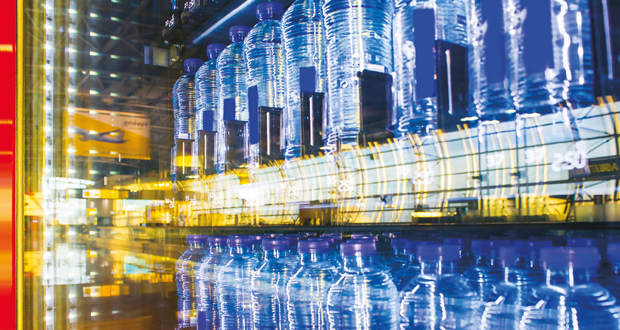MAINTENANCE PROMISE
For FMs looking for a vending supplier, many of which are regionally based SMEs, membership of the AVA has long been an important means of ensuring reliability, and as Llewellyn explains, an important part of AVA membership is guaranteed levels of service.
He says: “Our members are experts at looking after vending machines, storing and distributing fresh food and the extension into micro markets is just another way of offering an automated solution.
“What we’ve seen increasingly is technology aiding this process. Things moved slowly up to 2017/18 but we’ve now seen a surge in connected machines with now more than 80 per cent of the equipment out there, be it coffee, drinks or snacks connected one way or another.
“What that means in practice is that people are able to see when products are low and if there is a machine fault or vandalism, reaction times are much faster. In the past, maintenance was based on ‘we’ll go on a Tuesday’ but it’s not like that anymore. The routes are more economic, fuel is better used, which brings both cost and environmental savings, and this gives clients that service they need now, rather than how it suits the [supplier’s] route.”
He says technology is bringing many advantages to end users as well, for instance the growth in cashless vending over the past few years. Nearly 70 per cent of transactions in 2021 were cashless – versus 34 per cent in 2017 (AVA 2021 Census). Much of this driven by the pandemic, but also as a way of addressing costs and control.
Says Llewellyn: “Over half (55 per cent) of machines can now take cashless though most still have coin options, as around a third of transactions are still cash. But we’re seeing more and more use of tap and go payments using ID cards etc. which means a lot less cash in the machine that help keep costs and security issues down.
“Apps are also being offered to give the consumer more interactivity, whether with data learning or special offers. With data learning the app knows you like strong black coffee for instance, and with the introduction of touch screen panels the machine can provide all the calorific, ingredient and allergen information on products.
“And with automated retail units that utilise smart fridges and micro markets, plus internet connected machines, you now have machines which allow you to do a whole shop at work.”
ENVIRONMENTAL ISSUES
As outlined above, a huge area of importance for the AVA and its members are monitoring the raft of environmental proposals in the pipeline – many of which pertain to vending related products such as paper cups and plastic containers.
“Vending has always been a green industry but we’re being driven too by legislation,” says Llewellyn. “If we look at cups, when DEFRA launch the next stage of their Extended Producer Responsibility for Packaging there are proposals in there for a mandatory take back scheme for cups which encourages recycling. All paper cups are recyclable and reprocessing centres could recycle every paper cup that has ever been used, but the issue is in retrieving the used cups; which is why a mandatory takeback scheme would work well. Clients would be able to use their existing waste stream or access recycling or reclaim facilities.”
With bottles and cans the Scottish Deposit Return Scheme is being driven ahead for implementation in August of this year which will require consumers to pay a 20p deposit when they buy a glass bottle, can or plastic container. The money is then reimbursed when the empty containers are returned to a nominated return point.
Explains Llewellyn: “From a practical point of view it would be sensible for this scheme to be UK wide but such is the nature of the home nations’ Governments it’s not going to happen, which is a shame because this approach involves so much complexity. There’s a lot of activity going on, and we’re hoping we can get that these hurdles and move forward.”
He points out there have also been huge innovations in energy management, with vending equipment becoming ever more environmentally friendly, with for example, a large chilled vending machine now using less electricity than a home fridge. Within the sector around 60 per cent of machines in 2019 were refurbished or remanufactured for example.
VENDING FUTURE
Llewellyn believes that despite the rise in the cost of living, the vending and automated retail sector will continue to grow.
“There will be challenges ahead,” he says, “as the rate of inflation within foodservice and vending is nearly at 23 per cent, as there are a lot of cost pressures, including labour, logistics, fuel, energy, while coffee and cocoa prices are going up. However, most of our members are SMEs and have always been agile and nimble in making the best of a situation.
“So, while the greatest challenges will be getting through the cost pressures, the opportunities are still there. While vending has traditionally been driven by coffee and soft drinks, now we’re providing more fresh food via micro markets, adopting the latest technologies, as well as getting involved in distribution – including home deliveries.
“The growth is in different areas now and there’s an opportunity for those in the sector who want to do much more than offer coffee.”
For more info on the work of the AVA visit: www.the-ava.com







